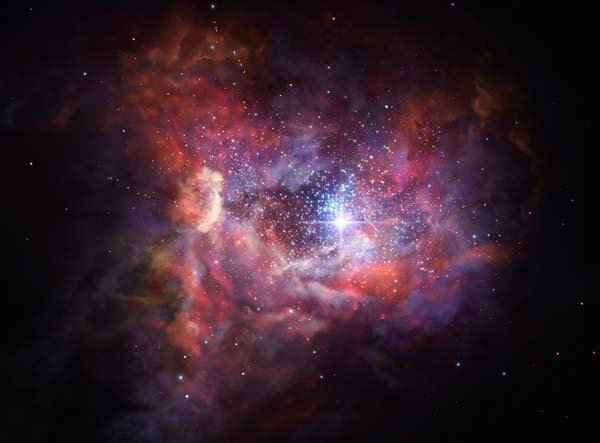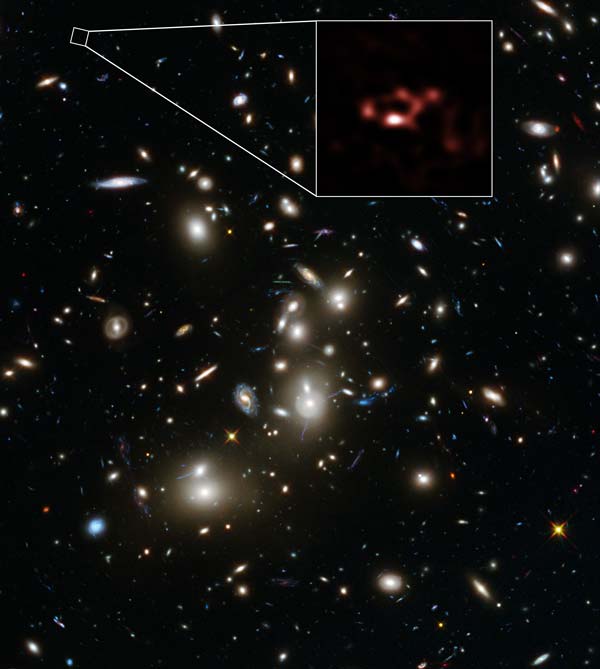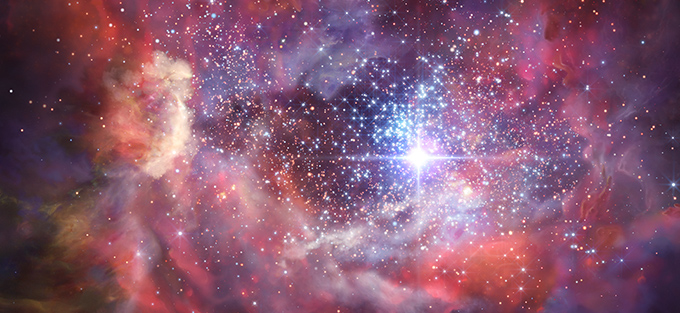Most Distant Object Ever Observed by ALMA Sheds Light on First Stars
8 March, 2017 / Read time: 7 minutes
ALMA Kids PublicationAstronomers have used the Atacama Large Millimeter/submillimeter Array (ALMA) to detect a huge mass of glowing stardust in a galaxy seen when the Universe was only four percent of its present age. This galaxy was observed shortly after its formation and is the most distant galaxy in which dust has been detected. This observation is also the farthest detection of oxygen in the Universe. These new results provide brand-new insights into the birth and explosive deaths of the very first stars.
The international team of astronomers, led by Nicolas Laporte of University College London, used ALMA to observe A2744_YD4, the youngest and most remote galaxy ever seen by this observatory. They were surprised to find that this young galaxy contained an abundance of interstellar dust — dust formed by the deaths of an earlier generation of stars.
Follow-up observations using the X-shooter instrument on ESO’s Very Large Telescope confirmed the enormous distance to A2744_YD4. The galaxy appears to us as it was when the Universe was only 600 million years old, during the period when the first stars and galaxies were forming [1].

“Not only is A2744_YD4 the most distant galaxy yet observed by ALMA,” comments Nicolas Laporte, “but the detection of so much dust indicates early supernovae must have already polluted this galaxy.”
Cosmic dust is mainly composed of silicon, carbon and aluminum, in grains as small as a millionth of a centimeter across. The chemical elements in these grains are forged inside stars and are scattered across the Cosmos when the stars die, most spectacularly in supernova explosions, the final fate of short-lived, massive stars. Today, this dust is plentiful and is an essential building block in the formation of stars, planets and complex molecules; but in the early Universe — before the first generations of stars died out — it was scarce.

The observations of the dusty galaxy A2744_YD4 were made possible because this galaxy lies behind a massive galaxy cluster called Abell 2744 [2]. Because of a phenomenon called gravitational lensing, the cluster acted like a giant cosmic “telescope” to magnify the more distant A2744_YD4 by about 1.8 times, allowing the team to peer far back into the early Universe.
The ALMA observations also detected the glowing emission of ionized oxygen from A2744_YD4. This is the most distant, and hence earliest, detection of oxygen in the Universe, surpassing another ALMA result from 2016.
The detection of dust in the early Universe provides new information on when the first supernovae exploded and hence the time when the first hot stars bathed the Universe in light. Determining the timing of this “cosmic dawn” is one of the holy grails of modern astronomy, and it can be indirectly probed through the study of early interstellar dust.
The team estimates that A2744_YD4 contained an amount of dust equivalent to 6 million times the mass of our Sun, while the galaxy’s total stellar mass — the mass of all its stars — was 2 billion times the mass of our Sun. The team also measured the rate of star formation in A2744_YD4 and found that stars are forming at a rate of 20 solar masses per year — compared to just one solar mass per year in the Milky Way [3].
This artist’s impression shows what the very distant young galaxy A2744_YD4 might look like and how supernovae explosions, the deaths of very massive and brilliant stars, polluted it with dust. ALMA observations of this galaxy, seen when the Universe was just 4% of its current age, are providing insights into the birth and explosive deaths of the very first stars in the Universe. Credit: ESO/M. Kornmesser
“This rate is not unusual for such a distant galaxy, but it does shed light on how quickly the dust in A2744_YD4 formed,” explains Richard Ellis (ESO and University College London), a co-author of the study. “Remarkably, the required time is only about 200 million years — so we are witnessing this galaxy shortly after its formation.”
This zoom video sequence starts with a flight through the faint constellation of Sculptor (The Sculptor). We soon see a rich group of distant galaxies, the cluster Abell 2744, known as Pandora’s Cluster. But continuing even further back into the early Universe we finish the trip looking at the dusty galaxy A2744_YD4, the most distant galaxy ever seen with ALMA. Credit: ALMA (ESO/NAOJ/NRAO), NASA, ESA, ESO and D. Coe (STScI)/J. Merten (Heidelberg/Bologna)/spaceengine.org/Digitized Sky Survey 2
This means that significant star formation began approximately 200 million years before the epoch at which the galaxy is being observed. This provides an excellent opportunity for ALMA to help study the era when the first stars and galaxies “switched on” — the earliest epoch yet probed. Our Sun, our planet and our existence are the products — 13 billion years later — of this first generation of stars. By studying their formation, lives and deaths, we are exploring our origins.
“With ALMA, the prospects for performing deeper and more extensive observations of similar galaxies at these early times are very promising,” says Ellis.
And Laporte concludes: “Further measurements of this kind offer the exciting prospect of tracing early star formation and the creation of the heavier chemical elements even further back into the early Universe.”
Notes
This time corresponds to a redshift of z=8.38, during the epoch of reionisation.
Abell 2744 is a massive object, lying 3.5 billion light-years away (redshift 0.308), that is thought to be the result of four smaller galaxy clusters colliding. It has been nicknamed Pandora’s Cluster because of the many strange and different phenomena that were unleashed by the massive collision that occurred over a period of about 350 million years. The galaxies only make up five percent of the cluster’s mass, while dark matter makes up seventy-five percent, providing the massive gravitational influence necessary to bend and magnify the light of background galaxies. The remaining twenty percent of the total mass is thought to be in the form of hot gas.
This rate means that the total mass of the stars formed every year is equivalent to 20 times the mass of the Sun.
Additional information
This research was presented in a paper entitled “Dust in the Reionization Era: ALMA Observations of a z =8.38 Gravitationally-Lensed Galaxy” by Laporte et al., to appear in The Astrophysical Journal Letters.
The team is composed of N. Laporte (University College London, UK), R. S. Ellis (University College London, UK; ESO, Garching, Germany), F. Boone (Institut de Recherche en Astrophysique et Planétologie (IRAP), Toulouse, France), F. E. Bauer (Pontificia Universidad Católica de Chile, Instituto de Astrofísica, Santiago, Chile), D. Quénard (Queen Mary University of London, London, UK), G. Roberts-Borsani (University College London, UK), R. Pelló (Institut de Recherche en Astrophysique et Planétologie (IRAP), Toulouse, France), I. Pérez-Fournon (Instituto de Astrofísica de Canarias, Tenerife, Spain; Universidad de La Laguna, Tenerife, Spain), and A. Streblyanska (Instituto de Astrofísica de Canarias, Tenerife, Spain; Universidad de La Laguna, Tenerife, Spain).
The Atacama Large Millimeter/submillimeter Array (ALMA), an international astronomy facility, is a partnership of the European Organisation for Astronomical Research in the Southern Hemisphere (ESO), the U.S. National Science Foundation (NSF) and the National Institutes of Natural Sciences (NINS) of Japan in cooperation with the Republic of Chile. ALMA is funded by ESO on behalf of its Member States, by NSF in cooperation with the National Research Council of Canada (NRC) and the Ministry of Science and Technology (MOST) in Taiwan and by NINS in cooperation with the Academia Sinica (AS) in Taiwan and the Korea Astronomy and Space Science Institute (KASI).
ALMA construction and operations are led by ESO on behalf of its Member States; by the National Radio Astronomy Observatory (NRAO), managed by Associated Universities, Inc. (AUI), on behalf of North America; and by the National Astronomical Observatory of Japan (NAOJ) on behalf of East Asia. The Joint ALMA Observatory (JAO) provides the unified leadership and management of the construction, commissioning and operation of ALMA.
Contacts
-
Nicolas Laporte
University College London, United Kingdom
Phone: +44 2 035 495 802
Cel: +44 7452 807 591
Email: [email protected]
-
Richard Ellis
ESO
Garching bei München, Germany
Phone: +44 7885 403334
Cel: +49 151 629 56829
Email: [email protected]
-
Nicolás Lira
Education and Public Outreach Coordinator
Joint ALMA Observatory, Santiago - Chile
Phone: +56 2 2467 6519
Cel: +56 9 9445 7726
Email: [email protected]
-
Richard Hook
Public Information Officer, ESO
Garching bei München, Germany
Phone: +49 89 3200 6655
Cel: +49 151 1537 3591
Email: [email protected]
-
Masaaki Hiramatsu
Education and Public Outreach Officer, NAOJ Chile
Observatory, Tokyo - Japan
Phone: +81 422 34 3630
Email: [email protected]
-
Charles E. Blue
Public Information Officer
National Radio Astronomy Observatory Charlottesville, Virginia - USA
Phone: +1 434 296 0314
Cel: +1 202 236 6324
Email: [email protected]

